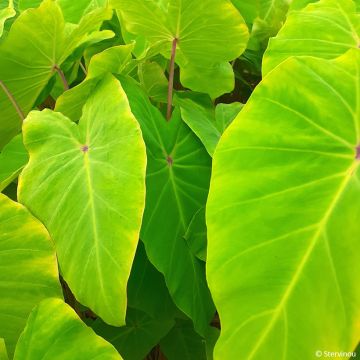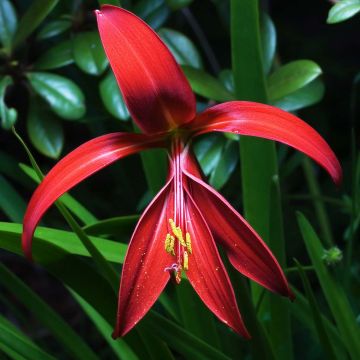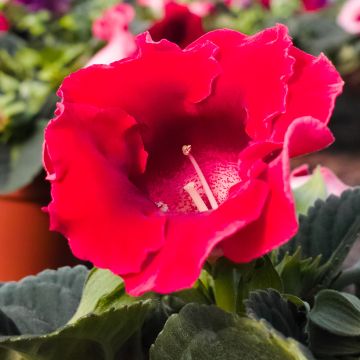

Colocasia esculenta - Taro
Colocasia esculenta - Taro
Colocasia esculenta Illustris
Taro, Elephant Ear, Eddoe
I am very happy with the product, which I was not familiar with, and with the advice given, I managed to grow it in a pot and it is magnificent. I hope to keep it for a long time.
Ely, 02/09/2025
Special offer!
Receive a €20 voucher for any order over €90 (excluding delivery costs, credit notes, and plastic-free options)!
1- Add your favorite plants to your cart.
2- Once you have reached €90, confirm your order (you can even choose the delivery date!).
3- As soon as your order is shipped, you will receive an email containing your voucher code, valid for 3 months (90 days).
Your voucher is unique and can only be used once, for any order with a minimum value of €20, excluding delivery costs.
Can be combined with other current offers, non-divisible and non-refundable.
Home or relay delivery (depending on size and destination)
Schedule delivery date,
and select date in basket
This plant carries a 12 months recovery warranty
More information
We guarantee the quality of our plants for a full growing cycle, and will replace at our expense any plant that fails to recover under normal climatic and planting conditions.

Would this plant suit my garden?
Set up your Plantfit profile →
Description
The Colocasia esculenta 'Illustris' is a variety of Taro or Elephant Ear. It develops large heart-shaped or lance-shaped leaves carried by long petioles. They are bright green with large purple-black patches. The visual result is a very dark leaf, veined with lime green. No two leaves are alike. Spectacular, this tropical plant loves water edges but also thrives indoors, provided it is bright and warm. In the ground, it is cultivated in partial shade in our rare regions spared by frost.
Undoubtedly originating from India and tropical Asia, the Colocasia esculenta spread long ago to tropical regions of South America and Oceania and later to tropical Africa. This perennial rhizomatous plant is a cousin of Arums and the Monstera deliciosa and belongs to the Arum family. With a slight tendency to sucker, this perennial herbaceous plant develops from a tuberous rhizome, forming a scaly corm covered with a thick skin. The mature plant is a large spreading clump that will measure, on average, 1.50 m in height and 80 cm in diameter at the base. It consists of magnificent peltate foliage, slightly elongated heart-shaped, light and bright green, veined with more or less blue-grey tinged with tender green. The leaf blade can reach 60 cm in length and 40 cm in width, carried by a violet-brown petiole, sheathing at the base. The leaf surface allows water to slide off; it has good water-repellent properties. During its growth, the plant branches out from the base and produces numerous sucker tubers that give rise to vigorous young plants. By removing an old leaf, two new ones take its place. Flowering occurs on mature plants in yellow spathes, mostly in summer.
'Illustris' stands out for the dramatic colour of its leaves, between this almost blackish purple and this bright green that, by contrast, appears practically fluorescent. On many leaves, green is mainly visible on the veins of the blade and at the petiole level. The size of the leaves is roughly the same as in the species, but they can sometimes reach up to 90 cm in length! Depending on the conditions, the plant reaches between 90 cm and 1.50 m in height and 90 cm to 1.20 m in width.
The Colocasia esculenta 'Illustris', also known as edible taro or Chinese cabbage, is a large perennial that thrives in waterlogged soil and is widely cultivated in tropical regions for its edible tuber. It is grown in containers on the terrace during summer and then moved to a veranda in winter. Still, its hardiness could allow it to withstand the mildest Mediterranean climates on the banks of a water feature, where it appreciates waterlogged and rich soils. A spectacular tropical plant brings a strongly exotic touch to the garden. Planted in partial shade, it becomes a focal point in a contemporary or exotic setting, combined with bamboo, hibiscus, a banana tree, or a Tetrapanax papyfera. Arums, Gunnera, and Dicksonia antarctica also come to mind. It is also an excellent indoor plant, just like the Monstera deliciosa.
Taro is consumed in Africa, China, Polynesia, and other parts of the world. Its tubers are rich in starch, and its young leaves are consumed like spinach.
Flowering
Foliage
Plant habit
Safety measures
Botanical data
Colocasia
esculenta
Illustris
Araceae
Taro, Elephant Ear, Eddoe
Colocasia antiquorum Illustris
Cultivar or hybrid
atteintescutaneomuqueuses
Cette plante peut provoquer l'apparition de réactions cutanées indésirables, une atteinte des yeux, ou des difficultés respiratoires si elle est ingérée.
Ne la plantez pas là où de jeunes enfants peuvent évoluer. Evitez tout contact avec la peau: privilégiez l'emploi de gants pour la manipuler. En cas de contact, lavez-vous soigneusement les mains et rincez abondamment à l'eau la zone concernée. Lavez les vêtements entrés en contact. En cas de réaction cutanée, contactez votre médecin ou le centre antipoison le plus proche de chez vous. En cas d'atteinte étendue ou de difficultés respiratoires, appelez immédiatement le 15 ou le 112.Pensez à conserver l'étiquette de la plante, à la photographier ou à noter son nom, afin de faciliter le travail des professionnels de santé.
Davantage d'informations sur https://plantes-risque.info
Other Colocasia
View all →Planting and care
Place your Colocasia in a bright indoor location, preferably in partial shade outdoors, to avoid leaf burn. They require a moist to, wet, fertile, humus-bearing soil and appreciate a nitrogen-rich fertiliser, such as grass clippings. You can plant your Colocasia in large containers, with regular and generous watering during the growing season and reduced watering in winter. If the atmosphere is too dry in winter, the plants may be susceptible to attacks from scale insects and red spiders. Usually grown as greenhouse or conservatory plants, they are non-hardy perennials.
Cultivation in open ground is possible in frost-free regions. In autumn, place a thick mulch around the base to protect the rootstock from the cold. The foliage may completely disappear, but the plant should regrow from the stump as soon as temperatures increase. If the soil becomes waterlogged in winter, the rootstock may rot, so the soil must be drained. Watch out for attacks from slugs and snails, which enjoy feeding on the young leaves.
Planting period
Intended location
Care
Planting & care advice
-
, onOrder confirmed
Reply from on Promesse de fleurs
Similar products
Haven't found what you were looking for?
Hardiness is the lowest winter temperature a plant can endure without suffering serious damage or even dying. However, hardiness is affected by location (a sheltered area, such as a patio), protection (winter cover) and soil type (hardiness is improved by well-drained soil).

Photo Sharing Terms & Conditions
In order to encourage gardeners to interact and share their experiences, Promesse de fleurs offers various media enabling content to be uploaded onto its Site - in particular via the ‘Photo sharing’ module.
The User agrees to refrain from:
- Posting any content that is illegal, prejudicial, insulting, racist, inciteful to hatred, revisionist, contrary to public decency, that infringes on privacy or on the privacy rights of third parties, in particular the publicity rights of persons and goods, intellectual property rights, or the right to privacy.
- Submitting content on behalf of a third party;
- Impersonate the identity of a third party and/or publish any personal information about a third party;
In general, the User undertakes to refrain from any unethical behaviour.
All Content (in particular text, comments, files, images, photos, videos, creative works, etc.), which may be subject to property or intellectual property rights, image or other private rights, shall remain the property of the User, subject to the limited rights granted by the terms of the licence granted by Promesse de fleurs as stated below. Users are at liberty to publish or not to publish such Content on the Site, notably via the ‘Photo Sharing’ facility, and accept that this Content shall be made public and freely accessible, notably on the Internet.
Users further acknowledge, undertake to have ,and guarantee that they hold all necessary rights and permissions to publish such material on the Site, in particular with regard to the legislation in force pertaining to any privacy, property, intellectual property, image, or contractual rights, or rights of any other nature. By publishing such Content on the Site, Users acknowledge accepting full liability as publishers of the Content within the meaning of the law, and grant Promesse de fleurs, free of charge, an inclusive, worldwide licence for the said Content for the entire duration of its publication, including all reproduction, representation, up/downloading, displaying, performing, transmission, and storage rights.
Users also grant permission for their name to be linked to the Content and accept that this link may not always be made available.
By engaging in posting material, Users consent to their Content becoming automatically accessible on the Internet, in particular on other sites and/or blogs and/or web pages of the Promesse de fleurs site, including in particular social pages and the Promesse de fleurs catalogue.
Users may secure the removal of entrusted content free of charge by issuing a simple request via our contact form.
The flowering period indicated on our website applies to countries and regions located in USDA zone 8 (France, the United Kingdom, Ireland, the Netherlands, etc.)
It will vary according to where you live:
- In zones 9 to 10 (Italy, Spain, Greece, etc.), flowering will occur about 2 to 4 weeks earlier.
- In zones 6 to 7 (Germany, Poland, Slovenia, and lower mountainous regions), flowering will be delayed by 2 to 3 weeks.
- In zone 5 (Central Europe, Scandinavia), blooming will be delayed by 3 to 5 weeks.
In temperate climates, pruning of spring-flowering shrubs (forsythia, spireas, etc.) should be done just after flowering.
Pruning of summer-flowering shrubs (Indian Lilac, Perovskia, etc.) can be done in winter or spring.
In cold regions as well as with frost-sensitive plants, avoid pruning too early when severe frosts may still occur.
The planting period indicated on our website applies to countries and regions located in USDA zone 8 (France, United Kingdom, Ireland, Netherlands).
It will vary according to where you live:
- In Mediterranean zones (Marseille, Madrid, Milan, etc.), autumn and winter are the best planting periods.
- In continental zones (Strasbourg, Munich, Vienna, etc.), delay planting by 2 to 3 weeks in spring and bring it forward by 2 to 4 weeks in autumn.
- In mountainous regions (the Alps, Pyrenees, Carpathians, etc.), it is best to plant in late spring (May-June) or late summer (August-September).
The harvesting period indicated on our website applies to countries and regions in USDA zone 8 (France, England, Ireland, the Netherlands).
In colder areas (Scandinavia, Poland, Austria...) fruit and vegetable harvests are likely to be delayed by 3-4 weeks.
In warmer areas (Italy, Spain, Greece, etc.), harvesting will probably take place earlier, depending on weather conditions.
The sowing periods indicated on our website apply to countries and regions within USDA Zone 8 (France, UK, Ireland, Netherlands).
In colder areas (Scandinavia, Poland, Austria...), delay any outdoor sowing by 3-4 weeks, or sow under glass.
In warmer climes (Italy, Spain, Greece, etc.), bring outdoor sowing forward by a few weeks.



























































